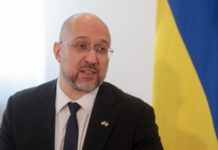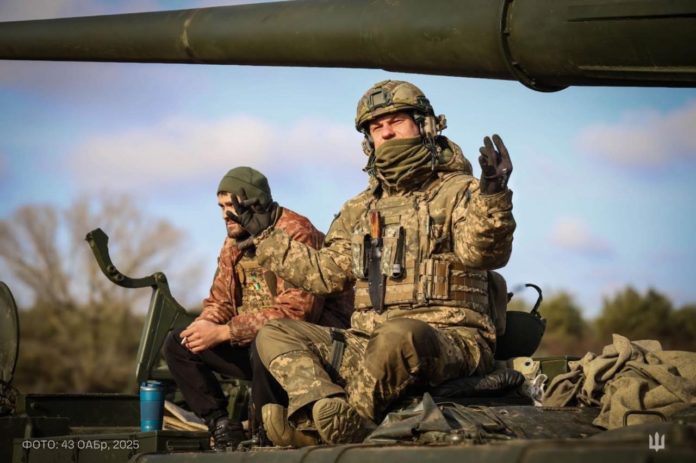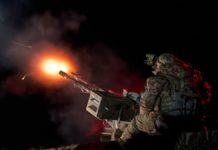The 1157th day of Russia’s large-scale military aggression against Ukraine has begun. The enemy, using its advantage in manpower and equipment, continues to attack our positions. Ukrainian defenders are steadfastly holding off the invaders, inflicting significant losses on the enemy. Fighting continues along the entire front line, with particularly intense clashes in Donetsk, Zaporizhzhia, and Luhansk regions. The enemy uses hundreds of air bombs, kamikaze drones, and missiles, but our defenders maintain their positions and effectively destroy enemy equipment and personnel.
Military Situation on the Frontlines
Throughout Day 1157 of the war, the situation on the frontlines remained extremely tense. Russian forces continue large-scale offensive actions across almost the entire line of contact. The fiercest battles are taking place in Donetsk, Luhansk, Zaporizhzhia, and southern directions. The enemy widely uses drones, guided air bombs, and artillery, but Ukraine’s defense remains steadfast and effective.
Overall, 175 clashes were recorded during the last 24 hours. The enemy carried out one missile and 110 airstrikes, launching 72 missiles and dropping 201 guided air bombs (KABs). In addition, there were 6,178 shellings, including 115 from multiple launch rocket systems, and 3,148 kamikaze drones were deployed.
-
Kupiansk direction: Four enemy attacks were stopped near Nova Kruhlyakivka, Zahryzovyi, and Bohuslavka.
-
Lyman direction: 15 attacks by the Russians near Novo, Kolodiziv, Torsk, Yampolivka, Olhivka, Ridkodub, and Novyi Mir.
-
Siversk direction: Eight unsuccessful attempts to storm near Bilohorivka, Verkhniokamianske, and Hryhorivka.
-
Kramatorsk direction: 13 clashes near Chasiv Yar, Andriivka, Bilohrady, Pretechyne, and Diliivka.
-
Toretsk direction: 17 enemy attacks near Toretsk, Leonidivka, Shcherbynivka, Dachne, Diliivka, and Novospaske.
-
Pokrovsk direction: 65 assaults were recorded on over 20 settlements, including Sukhy Yar, Yelizavetivka, Andriivka, Kotlyarivka, Myrolubivka.
-
Novopavlivsk direction: 10 attacks near Kostyantynopil, Pryvilne, Rozlyv, and Odradne.
-
Orikhivsk direction: Nine attempts by the enemy to advance near Novodanylivka, Stepove, Shcherbaky, and Malyi Tokmachka.
-
Dnipro direction: Three attacks were stopped by our forces.
-
Hulyaipilsk and Kharkiv directions: No clashes recorded.
In operations behind enemy lines in Kursk Oblast, Ukrainian units thwarted 27 attacks, countered 17 airstrikes, and 367 shellings.
A massive drone attack: On the night of April 25, Russia attacked with 103 Shahed drones, 41 of which were destroyed, and 40 lost control. The affected areas included Kharkiv, Sumy, Cherkasy, Donetsk, and Dnipropetrovsk regions.
The defensive actions of the Armed Forces of Ukraine remain effective — thanks to flexible maneuvers, mobile fire groups, and effective air defense, the enemy suffers losses and has not achieved breakthroughs in any of the directions.
Russian Losses
The Russian army has sustained significant losses during the past 24 hours as a result of effective actions by the Ukrainian Armed Forces. The intensity of combat operations, along with the activity of Ukrainian artillery, aviation, and air defense, has significantly reduced the enemy’s combat potential.
- Personnel — approximately 946,500 (+1,170 in the past 24 hours);
- Tanks — 10,703 (+9);
- Armored fighting vehicles — 22,315 (+3);
- Artillery systems — 26,895 (+72);
- MLRS — 1,372 (+3);
- Air defense systems — 1,144 (+3);
- Aircraft — 370 (no change);
- Helicopters — 335 (no change);
- Operational-tactical UAVs — 33,779 (+119);
- Cruise missiles — 3,196 (+48);
- Ships/cutters — 28 (no change);
- Submarines — 1 (no change);
- Automotive equipment and fuel tankers — 45,906 (+151);
- Special equipment — 3,860 (no change).
Daily enemy losses indicate a high rate of depletion of Russian forces. The Ukrainian Armed Forces continue to effectively destroy enemy personnel and equipment despite the scale of attacks by the adversary.
Achievements of the Ukrainian Armed Forces and Targeted Enemy Sites
Ukraine’s aviation, missile troops, and artillery successfully targeted:
-
Six concentration areas of enemy personnel, weapons, and military equipment;
-
Nine artillery systems;
-
One enemy command post.
Thus, the Ukrainian Armed Forces continue to systematically undermine the aggressor’s offensive capabilities, effectively destroying its personnel, equipment, and command centers.
Diplomatic Initiatives and Negotiations
From April 24–25, 2025, diplomatic efforts to end the war in Ukraine have intensified, but remain controversial and complex. The United States, EU, Ukraine, and Russia continue discussions on potential peace settlement, but key disagreements, especially over the status of Crimea and occupied territories, prevent consensus.
- US President Donald Trump presented a peace plan that includes recognizing Russia’s control over Crimea and parts of occupied territories without officially transferring sovereignty. Ukraine and European partners rejected this proposal, insisting on full restoration of Ukraine’s territorial integrity.
- During negotiations in London on April 23, Ukrainian and European representatives proposed an alternative plan, which includes an immediate ceasefire, the return of deported children, the exchange of all prisoners, security guarantees, and the preservation of Ukraine’s European integration course.
- President Trump accused President Zelensky of unwillingness to compromise, calling his position “destructive.” He also threatened to withdraw the United States from the negotiation process.
- During President Zelensky’s visit to South Africa, President Cyril Ramaphosa called for the start of negotiations without preconditions. The visit was interrupted due to a missile attack on Kyiv.
- French President Emmanuel Macron reaffirmed the EU’s position on the inadmissibility of recognizing Crimea’s annexation, emphasizing that Russia remains the main threat to global stability.
Despite active diplomatic efforts, achieving a peace agreement remains distant. The main disagreements over Ukraine’s territorial integrity, security guarantees, and ceasefire conditions continue to complicate the negotiation process. Ukraine and its European partners insist on respect for sovereignty and international law, while the United States and Russia push for proposals that require significant concessions from Kyiv.
International Support for Ukraine
From April 24–25, 2025, international support for Ukraine focused on strengthening defense capabilities and developing its defense-industrial base.
- The European Union announced the allocation of half of €2 billion obtained from frozen Russian assets to the development of Ukraine’s defense industry, specifically artillery.
- Denmark agreed to a new aid package worth 317 million Danish kroner to purchase artillery shells through Estonia.
- New Zealand announced the continuation of military support to Ukraine until December 2026, maintaining the mission of trainers to prepare Ukrainian servicemen in Europe.
- The UK and the EU are preparing a defense and security pact, allowing British companies to participate in the SAFE project worth €150 billion to strengthen joint defense industry.
- NATO has called on its allies to increase support for Ukraine, emphasizing the need to invest in strengthening its defense capabilities.
Thus, Ukraine’s partners are focusing not only on the immediate supply of weapons but also on the long-term strengthening of the country’s security and defense capacities.
Humanitarian Situation in Ukraine
From April 24–25, 2025, the humanitarian situation in Ukraine significantly worsened due to massive missile and drone attacks by Russia, causing significant casualties among civilians and extensive destruction of infrastructure.
- In Kyiv, at least 12 people were killed in a massive attack, and over 90 were injured. Residential buildings were destroyed in several city districts.
- In Pavlohrad, Dnipropetrovsk region, three people, including a child, were killed in a drone strike, and ten others were injured.
- In Marganets, a Russian drone attacked a passenger bus, killing nine people, and more than 30 were wounded.
- In Kharkiv, Zhytomyr, and Zaporizhzhia, residential areas and critical infrastructure were hit.
- International humanitarian organizations, including “Doctors Without Borders” and CARE, have stepped up medical and psychological aid to the affected.
Overall, according to the UN, the number of civilian casualties in April increased by 46% compared to March, indicating an escalation in Russia’s aggression against Ukraine.
Domestic Situation in Ukraine
During April 24–25, 2025, important internal changes took place in Ukraine, aimed at strengthening mobilization potential, supporting the economy during the war, and improving social security.
- The Verkhovna Rada adopted a law establishing a Unified Electronic Register of Military Personnel, which is set to be operational by July 2025. It simplifies procedures for military registration and mobilization.
- The President of Ukraine signed a law to strengthen social protection for military personnel, increasing compensation for the families of fallen defenders.
- The Ministry of Health of Ukraine launched a new psychological rehabilitation program for war veterans and their families with international partners’ support.
- The Ministry of Economy presented the “Restore Ukraine” program, which includes new grants for small businesses in construction, processing, and IT sectors.
- The “Diia” app launched a new function allowing citizens to apply for compensation for destroyed housing as part of the state reconstruction program.
These measures aim to enhance the country’s mobilization readiness, support the families of military personnel, and stimulate economic recovery in wartime.
Conclusion
As of April 25, 2025, the situation on the frontlines of Ukraine remains intensely tense. Russia continues large-scale attacks, but Ukrainian defense forces demonstrate high effectiveness and resilience, successfully holding off the enemy and inflicting significant losses. Diplomatic efforts and new support packages signal continued international backing for Ukraine. Meanwhile, internal reforms focus on strengthening mobilization, supporting military families, and stimulating economic recovery, which are crucial for maintaining national stability during this prolonged conflict.
🤝 SUPPORT US 💙💛
We continue to work only because you read and support us. If you appreciate what we do, please become our sponsor or donate here👇
☕️ buymeacoffee.com/meaninuak
or
☑️ patreon.com/MeanwhileinUkraine
Your support helps us continue delivering timely and accurate updates. Stay informed and stand with Ukraine! 🇺🇦
Together we are stronger! 🇺🇦
























